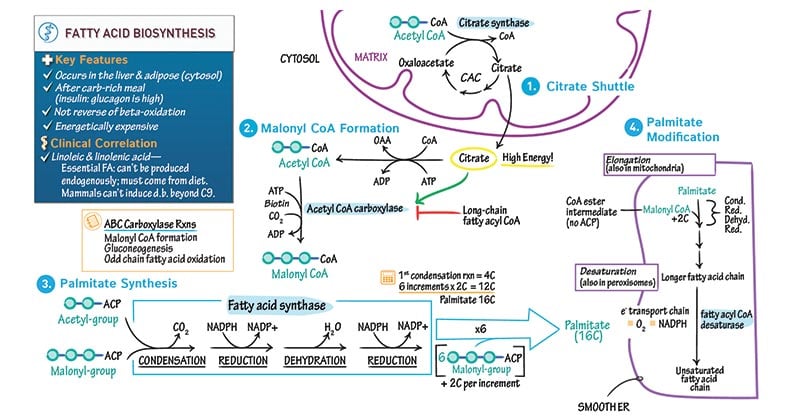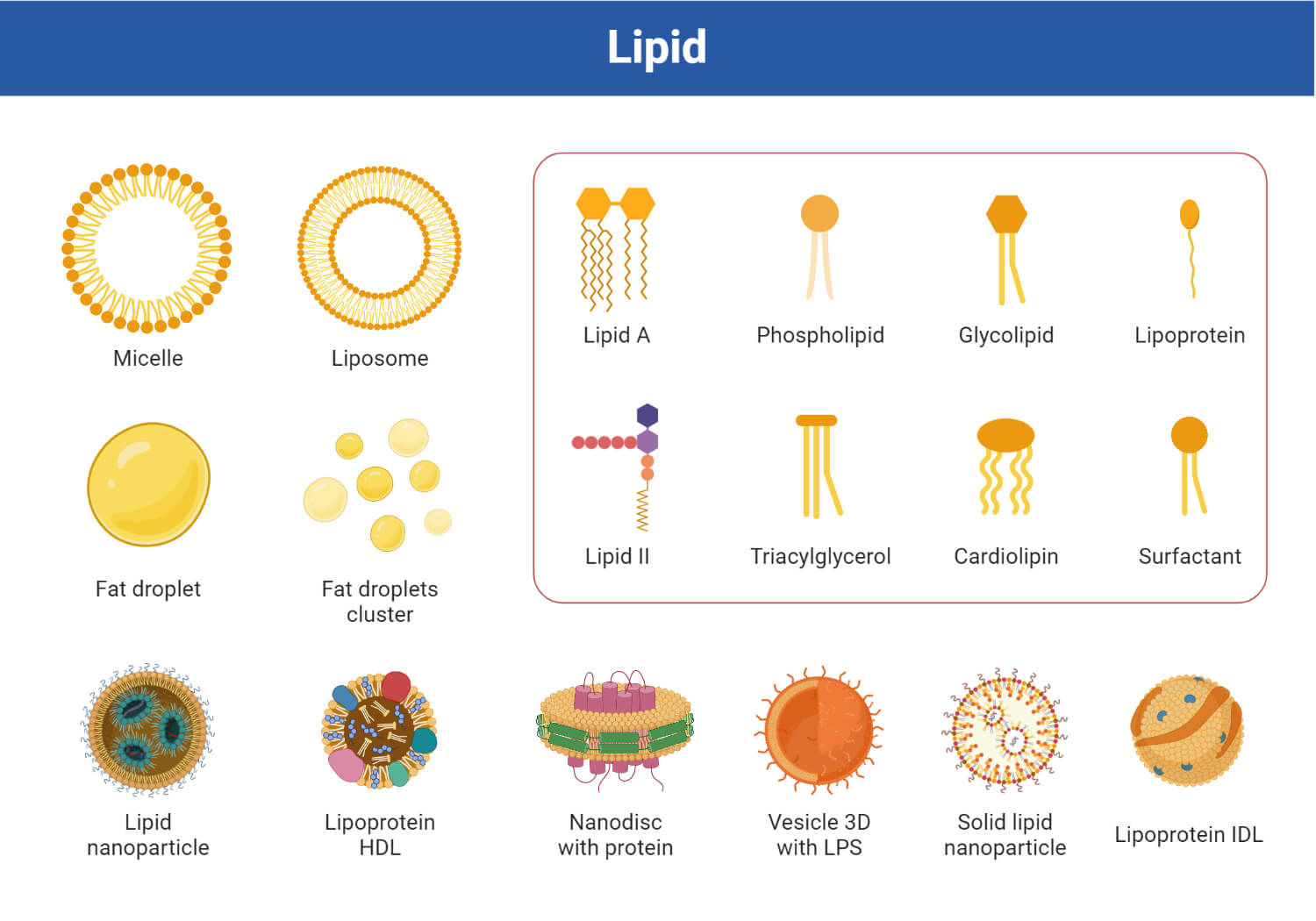Our body’s structural molecules and energy storage depend on fatty acids. They are essential for several physiological activities, such as the creation of cell membranes, cell signaling, and energy generation. These fatty acids are produced by an intricate and strictly controlled process that involves several metabolic and enzymatic processes. We will explore subjects like straight-chain fatty acids, unsaturated straight-chain fatty acids, odd-chain fatty acids, branched-chain fatty acids, omega-alicyclic fatty acids, and the synthesis of tuberculostearic acid as we dig into the complex world of fatty acid production in this article.

Interesting Science Videos
Fatty Acid Synthesis Pathway
Fatty acid synthesis encompasses a complex series of enzymatic reactions that involve the conversion of acetyl-CoA to malonyl-CoA, followed by the sequential addition of two-carbon units to elongate the growing fatty acid chain in the fatty acid synthase (FAS) complex.
- This process involves condensation, reduction, dehydration, and subsequent reduction steps, resulting in the synthesis of saturated straight-chain fatty acids.
- For the production of unsaturated straight-chain fatty acids, additional desaturation reactions are involved, either anaerobically or aerobically.
- Odd-chain fatty acids and branched-chain fatty acids have unique biosynthetic pathways, while omega-alicyclic fatty acids and tuberculostearic acid synthesis are specific to certain organisms.
- These pathways contribute to the diverse array of fatty acids found in biological systems and are essential for understanding lipid metabolism, health implications, and potential therapeutic interventions.
Straight-Chain Fatty Acid
Straight-chain fatty acids, as the name suggests, are fatty acids with a linear carbon chain. They can be further classified into saturated and unsaturated straight-chain fatty acids based on the presence or absence of double bonds between carbon atoms in their carbon chain
Saturated Straight-Chain FA
- There are no double bonds between the carbon atoms in the carbon chain of saturated straight-chain fatty acids.
- These fatty acids are generally produced by the process of lipogenesis, which transforms carbohydrates into fatty acids.
- A number of essential enzymes control the primary locations where lipogenesis takes place, which include the liver and adipose tissue.
- Acetyl-CoA is produced as the first step in the metabolic process, which transforms carbs into fatty acids.
- The synthesis of fatty acids then uses acetyl-CoA as a substrate and takes place in the cytoplasm of cells.
- A sequence of events that are catalyzed by enzymes including acetyl-CoA carboxylase, fatty acid synthase, and different elongases and desaturases result in the production of fatty acids.
- While carbohydrates can be synthesized from fatty acids through a process called gluconeogenesis, animals cannot resynthesize carbohydrates from fatty acids.
- This inability to convert fatty acids back into carbohydrates underscores the importance of maintaining a balance between energy intake and expenditure.
Unsaturated Straight-Chain FA
On the other hand, unsaturated straight-chain fatty acids have one or more double bonds inside their carbon chain.
- Anaerobic desaturation and aerobic desaturation are the two separate methods used to introduce double bonds.
- Certain microbes do anaerobic desaturation, which includes adding double bonds to fatty acids in the absence of oxygen.
- Anaerobic desaturases are specialized enzymes that catalyze this action.
- In contrast, aerobic desaturation takes place in higher species, including humans, and the desaturate enzymes involved in the process need oxygen as a cofactor.

Odd Chain Fatty Acid
Another category of fatty acids that have an odd number of carbon atoms in their carbon chain are known as odd-chain fatty acids. Despite being less prevalent than their even-chain cousins, these fatty acids are nonetheless crucial to many biological functions. Certain amino acids, including valine and isoleucine, can be broken down to produce odd-chain fatty acids. Propionyl-CoA is produced during the breakdown of these amino acids, and through a series of enzymatic processes, it may then be changed into odd-chain fatty acids.
Branched Chain Fatty Acid
As the name indicates, branched-chain fatty acids have one or more branches in their carbon chain. The branched-chain fatty acid synthesizing system is a unique enzymatic system that is involved in the production of branched-chain fatty acids. To add branches to the fatty acid molecule, this system makes use of a particular enzyme known as branched-chain fatty acid synthase. Branch-chain fatty acid synthesis is a crucial mechanism in some microorganisms and has effects on a number of biological phenomena.
Omega Alicyclic Fatty Acid
- Omega-alicyclic fatty acids are a special class of fatty acids with a methyl group at the omega end of the carbon chain and a cyclic structure.
- Certain marine species contain these fatty acids, which have been linked to a number of health advantages, including anti-inflammatory and cardiovascular protective actions.
- Omega-alicyclic fatty acids are produced by particular enzymatic processes that are not being completely understood.
- To learn more about these particular fatty acids’ biosynthetic processes and physiological roles, researchers are actively working to identify possible therapeutic uses.
Tuberculostearic Acid
Tuberculostearic acid is one fatty acid in particular that requires attention. The cell walls of Mycobacterium tuberculosis, the bacteria that causes TB, contain the unique fatty acid known as tuberculostearic acid.
- The impermeability and resilience of the bacterial cell wall to host immune defences are two characteristics that are made possible by this fatty acid.
- There is a unique route used only in the production of tuberculostearic acid, which is not found in any other species.
- Two molecules of palmitoyl-CoA are condensed to create phthioceranic acid, a dimeric intermediate that is the first step in the production of tuberculostearic acid.
- Tuberculostearic acid is produced by further modifying this dimeric intermediate by a number of enzymatic processes, such as reduction, methylation, and dehydration.
- Understanding the enzymes involved in this process, which are exclusive to Mycobacterium TB, might help researchers create new anti-tuberculosis medications.
Importance of Fatty Acid
Understanding the complexity of fatty acid production is crucial for deciphering the workings of lipid metabolism. Still, it also has huge ramifications for the creation of drugs, food, and other industries.
- In the pathophysiology of various metabolic illnesses, including obesity, diabetes, and cardiovascular diseases, dysregulation of fatty acid production has been suggested.
- Researchers can discover new therapeutic targets and create plans to modify lipid metabolism for therapeutic reasons by better understanding the enzymes and metabolic pathways involved in fatty acid production.
- The investigation of fatty acid production also provides new opportunities for nutritional therapy.
- It has been demonstrated that dietary changes to fatty acid consumption, such as changing the proportion of saturated to unsaturated fats, have an effect on health outcomes.
- For instance, enhanced cardiovascular health has been linked to consuming less saturated fat and more unsaturated fats, especially omega-3 fatty acids.
- A more complex knowledge of how dietary choices might affect health and illness is made possible by studying the production of various kinds of fatty acids.
Furthermore, developments in lipid research may influence medication development initiatives. Numerous disease processes, such as cancer, neurological diseases, and metabolic syndromes, are tightly correlated with lipid metabolism.
- Researchers can create innovative treatment approaches to alter lipid metabolism in these disorders by focusing on specific enzymes or metabolic pathways involved in fatty acid production.
- In addition, Mycobacterium tuberculosis’ production of tuberculostearic acid is a possible target for the creation of fresh anti-tuberculosis medications.
- It may be feasible to compromise the integrity of the bacterial cell wall and improve the effectiveness of currently available TB therapies by interfering with the special enzymatic pathway involved in tuberculostearic acid formation.
Conclusion
The production of straight-chain fatty acids, both saturated and unsaturated, as well as the synthesis of odd-chain fatty acids, branched-chain fatty acids, omega-alicyclic fatty acids, and tuberculostearic acids are all included in the complex and tightly controlled process known as fatty acid synthesis. Each of these subtopics demonstrates how varied and complex lipid metabolism is. Understanding the methods and control of fatty acid production can help us better understand the complexity of lipid biology and perhaps even create therapies that specifically target lipid-related illnesses. It is crucial to do more study in this area in order to further our understanding and create cutting-edge treatment approaches that will improve human health and well-being. Fatty acid synthesis research is promising since it advances our understanding of basic biological processes.
References
- Henry, Susan A., Sepp D. Kohlwein, and George M. Carman. “Metabolism and regulation of glycerolipids in the yeast Saccharomyces cerevisiae.” Genetics 190.2 (2012): 317-349.
- Jenkins, Benjamin, James A. West, and Albert Koulman. “A review of odd-chain fatty acid metabolism and the role of pentadecanoic acid (C15: 0) and heptadecanoic acid (C17: 0) in health and disease.” Molecules 20.2 (2015): 2425-2444.
- Lee, Je Min, et al. “Fatty acid desaturases, polyunsaturated fatty acid regulation, and biotechnological advances.” Nutrients 8.1 (2016): 23.
- Lipid Metabolism – https://bio.libretexts.org/Bookshelves/Microbiology/Microbiology_(Boundless)/05%3A_Microbial_Metabolism/5.07%3A_Alternatives_to_Glycolysis/5.7E%3A_Lipid_Metabolism
